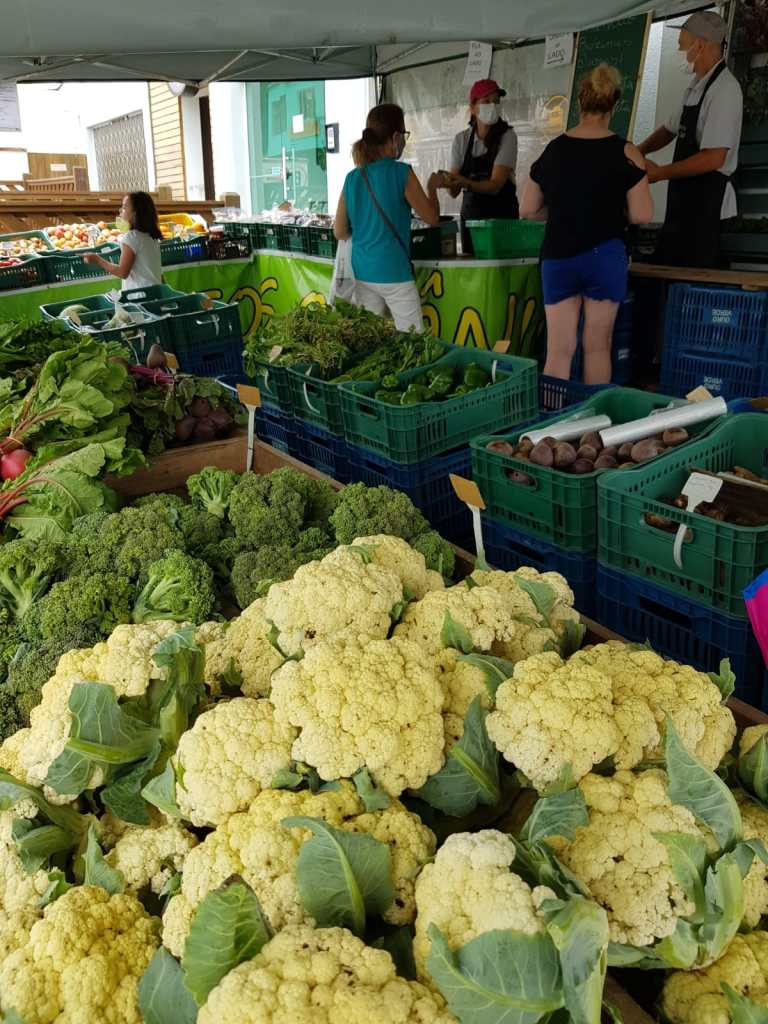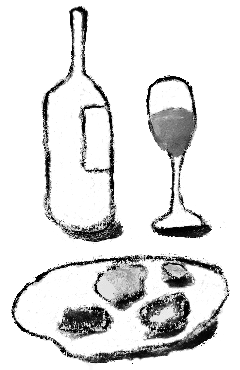
I’ve spent the last three months away from Florianópolis. One of the things that makes me feel most at home is buying most of the items I need to cook at the agroecological fair that takes place once a week in a neighborhood not far from where I live. I arrived in the city on Tuesday and did a bit of food shopping, but I waited until Saturday, the day of the week when the fair takes place, to make a larger purchase, thinking about what I would use to cook for the next seven days or so.
It’s not that this is the only fair in the city, there are others that are much bigger and have more food on offer, but this is a fair not so far from my home, and one that I’m used to going to. It’s just one stall, run by a couple who come from São Bonifácio, a town near Florianópolis. I always exchange a few words with them, we have a few laughs, I feel very comfortable buying there and I’m happy to have this dialogue with those who produce what I eat, an opportunity that is increasingly rare in many urban contexts.
So, finally, on Saturday morning, I arrived at the fair site, but the space set aside for it was absolutely empty. I thought the couple might have had an unforeseen event that day, but that wasn’t the case. I went into a natural products store on the same corner as the fair and asked if anyone had any information about why the stall wasn’t there.
To my surprise, the answer I got was that the fair hadn’t been operating there for some time. The explanation was that, due to the heavy rains in Santa Catarina over the last two months, the stall owners had lost a lot of food. Because of this, they decided to first build a greenhouse to grow the food, to ensure that they wouldn’t have to make any more losses, and only after that would they resume working at the fair.
When I received the news that there was no forecast for their return, I felt a little orphaned and even a little lost. From the fair I sorted out most of my food for the week, I already planned myself in a way, I knew more or less what I was going to find there and what to buy. It was my weekly routine to buy some basic foods, such as onions, garlic, beans, rice and also seasonal vegetables and fruit, as well as items such as honey, bread and some cookies. I always returned home with two or even three bags full of various items.
I’ve always been a bit averse to routines or repeating the same routes many times, including shopping. It was a structuring event for my diet and even for my week, because I wouldn’t have to go elsewhere to buy fresh food until the next Saturday. However, I realized that I already had a certain attachment to the routine of going to that fair, and in a very positive sense.
I was sorry not to find the market, but it’s certain that the couple who ran it must have felt a much greater impact, given the losses they had accumulated. I could simply look for another fair or buy food at an organic produce warehouse, it wouldn’t be a big problem. But for the couple and the other producers who also sent products to that stall, the changes would be much more difficult to deal with at the moment. And this made me think with regret about the number of small farmers who have suffered successive losses as a result of climate change and how this is likely to worsen in the coming years, affecting populations in different corners of the world, as various experts have predicted.
Buying food at the agroecological fair also means helping these farmers to continue their work in the fields. In Brazil, it’s not agribusiness with its large areas of land devoted to soy, corn and cotton that feeds the population. It’s the small producers, like that couple and their neighbors, who ensure that most of the fresh food reaches our tables. I’m not sure if the rainfall over the last few months in Santa Catarina, and specifically in the region where the food at the fair is grown, is directly related to the climate crisis, because Santa Catarina is a state of intense, frequent and long-lasting rainfall, at least since I’ve lived here. Even so, what happened to the fair is still a warning sign of an increasingly uncertain future for food, given some of the extreme events we have been witnessing more and more frequently.
#Rip temporário à feira e as mudanças climáticas
Passei os últimos três meses fora de Florianópolis. Uma das coisas que mais me faz sentir “chegar em casa” é comprar a maior parte dos itens para cozinhar na feira agroecológica que acontece uma vez por semana em um bairro não muito distante de onde moro. Cheguei terça-feira na cidade, fiz algumas poucas compras de comida, mas esperei até sábado, dia da semana em que acontece a feira, para então fazer uma compra maior, pensando no que utilizo para cozinhar no período de mais ou menos sete dias.
Não é que essa seja a única feira da cidade, existem outras até bem maiores e com mais ofertas de alimentos, mas essa é uma feira não tão distante da minha casa, e que já estou habituada a frequentar. É somente uma banca, mantida por um casal que vem de São Bonifácio, cidade próxima a Florianópolis. Sempre troco algumas palavras com eles, damos algumas risadas, me sinto bastante à vontade de comprar ali e contente de ter essa interlocução com quem produz aquilo que como, uma oportunidade cada vez mais rara em muitos contextos urbanos.
Pois bem, finalmente no sábado pela manhã, cheguei no local da feira, mas o espaço destinado a ela estava absolutamente vazio. Pensei que pudesse ter acontecido um imprevisto com o casal e bem no dia em que eu retornava à feira, mas não era isso. Entrei numa loja de produtos naturais localizada na mesma esquina onde ocorre a feira e perguntei se alguém tinha alguma informação do porque a banca não estava ali. Para minha surpresa, a resposta que obtive é que havia algum tempo a feira já não estava funcionando ali. A explicação foi que, devido às chuvas intensas em Santa Catarina nos últimos dois meses, os proprietários da banca perderam muitos alimentos. Em razão disso, decidiram primeiro construir uma estufa para cultivar os alimentos, garantir que não teriam mais prejuízos, e só depois disso retomariam o trabalho na feira.
Quando recebi a notícia de que não havia previsão para a volta deles, me senti um pouco órfã e até mesmo um pouco perdida. A partir da feira eu resolvia a maior parte da minha alimentação durante a semana, já me programava de certa forma, sabia mais ou menos o que iria encontrar ali e o que comprar. Era minha rotina semanal para comprar alguns alimentos básicos, como cebola, alho, feijão, arroz e também verduras, legumes e frutas da estação, além de itens como mel, pão e algum biscoito. Sempre voltava com duas ou até mesmo três sacolas cheias de itens variados para casa.
Sempre fui um pouco avessa a rotinas ou a repetir muitas vezes os mesmos percursos, incluindo locais de compras. Era um evento estruturante da minha alimentação e mesmo da minha semana, porque não precisava recorrer a outros lugares para comprar alimentos frescos até o próximo sábado. No entanto, percebi que eu já tinha um certo apego à rotina de ir àquela feira e num sentido muito positivo.
Lamentei não encontrar a feira, mas é certo que o casal que a mantinha deve ter sentido um impacto bem maior, dados os prejuízos que acumularam. Eu poderia simplesmente buscar uma nova feira ou comprar alimentos em um entreposto de produtos orgânicos, não seria um grande problema. Já para o casal e para outros produtores que também enviavam produtos para aquela banca, as mudanças seriam bem mais difíceis de contornar neste momento. E isso me fez pensar com pesar na quantidade de pequenos agricultores que vêm tendo prejuízos sucessivos com as mudanças do clima e como isso tende a se agravar nos próximos anos, afetando populações nos diferentes cantos do mundo, conforme vêm prevendo diversos especialistas.
Comprar os alimentos na feira agroecológica também significa colaborar para que esses agricultores possam seguir seu trabalho no campo. No Brasil, quem alimenta a população não é o agronegócio com suas grandes áreas de terra destinadas à soja, milho e algodão. São os pequenos produtores, a exemplo daquele casal e de seus vizinhos, que garantem a chegada da maior parte dos alimentos frescos em nossa mesa. Não tenho certeza se essas chuvas nos últimos meses em Santa Catarina e, especificamente, na região onde são cultivados os alimentos da feira, têm relação direta com a crise climática, pois Santa Catarina é um estado de chuvas intensas, frequentes e duradouras, ao menos desde que moro por aqui. Mesmo assim, o que ocorreu com a feira não deixa de ser um sinal de alerta para um futuro cada vez mais incerto com relação à alimentação, dados alguns eventos extremos que temos presenciado de forma cada vez mais frequente associados ao avanço da crise climática.
